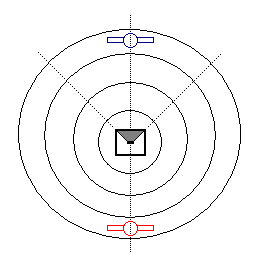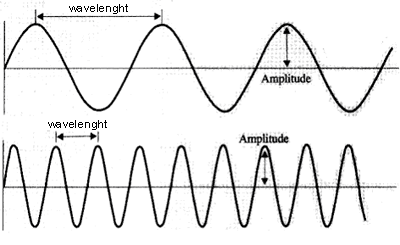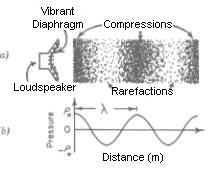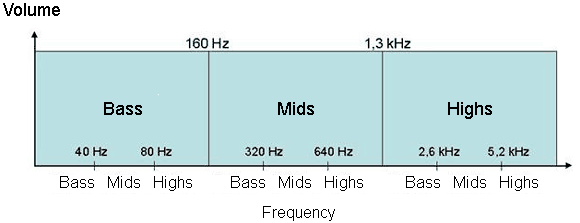LIVE ROOM - DEAD ROOM - DRY ROOM
Which is the best room to listen to music?
First
Part
Jorge
Knirsch
Introduction
The concept
holds, now deeply rooted and consolidated in the market of audio and
video and also among us, lovers of music and image, and among acoustic
engineers too, that "a good room for reproducing music and shows has to
be necessarily live, or if it’s not for this purpose, at least it must
be a semi-live room". There are controversies about the issue of how
live a room must be, but all agree that it must be live or semi-live.
And putting such premise to work, we observe an interaction between the
specific room under consideration and that which is being reproduced. In
other words, by setting up our audio system in a live room, we create a
new audible and particular solution, which shows itself to be superior
to the sound results coming from one system alone.
If you pay close attention
nowadays, the great majority of environments tend to be live, and public
places mainly are like this, such as airports, bus stations and many
others, in spite of very few exceptions, such as some movie and play
theaters. And we’re not aware there is a large influence from such
environments in our well-being, a much neglected aspect among us.
In this article we intend
first of all to study sound waves in a broad way, presenting some
physical concepts which normally aren’t mentioned but are very important
to acoustics. Then, we’re going to study and define one of the most
important parameters in acoustics, Reverberation Time (RT), showing its
influence on listening, in order to suit it to the several existing
rooms. We’ll define the various room types in this occasion, the live
ones, the dead ones (also called deaf rooms by recording staffs), and
dry rooms, so as to decide then which of them is the best option to us.
We’ll also examine what comes to be listening comfort, how to attain it,
and what its consequences are for our emotional.
© 2004-2008 Jorge Bruno Fritz Knirsch
Todos os direitos reservados
http://www.byknirsch.com.br
Sound
Waves
From the start, I did not
think I would be writing a whole article on sound waves, but there
wasn’t time enough. Happenings have stepped over actions, in a way that
now I intend to be quite brief regarding this subject, in spite of the
fact that the subject is of vital concern, and enter reverb time
analysis right away. I do this so that you can follow me through
regarding the presentation of physical phenomena and of the technical
aspects we are going to deal with next.
There are various types of
waves in physics. Mechanical waves among them are produced by
disturbances, that is, particles vibrating in a come-and-go, in a given
medium. Through such vibrations mechanical waves are transmitted.
Mechanical waves can be felt and seen. For example, we see them in
springs, in the strings of an acoustic guitar, in water. They do not
exist in a vacuum, for there are no particles there. They are
progressive, that is, they move away from the source (point of their
emission), carrying energy without transferring matter. They have
several characteristics, such as frequency, wavelength, speed, amplitude
and phase. We’re going to see some of these characteristics ahead, in
more detail. They may also undergo some important physical processes
such as reflection, refraction, diffraction, interference or
superimposition, and polarization. Some of these physical processes
we’re going to study now.
There are two kinds of
mechanical waves: transversal and longitudinal waves. In transversal
mechanical waves, the disturbances, that is, come-and-go vibrations,
take place orthogonally with respect to energy transfer. In other words,
vibrations are orthogonal to their transmission or propagation
movements. For example, we see this in waves that propagate in strings
tied by one end. The waves we see in the water surface are another
example.
In longitudinal mechanic
waves, the disturbances, that is, particles’ come-and-go vibrations,
take place in the direction of movement. One example of such wave type
is found in springs, where waves propagate longitudinally, in the
direction of energy transmission. Sound waves are also longitudinal
mechanic waves. They can be generated in a loudspeaker or in any musical
instrument for example.
A sound wave represents a
mechanical wave front, with air pressure
 variation,
though it propagates in all directions after its emission. Contrary to
what I saw written in many Websites, sound waves are longitudinal, but
their propagation is spherical. This is the first very important
physical concept: sound waves are longitudinal mechanical waves with
spherical propagation, diffusing themselves in all directions after
their point of emission. This aspect, not very much known and also
little mentioned, is represented in the sideway figure, in just one
plane, but try to visualize it now in spherical form - imagine a
loudspeaker placed in space, surrounded by air all round it, and having
no reflective surface near it. Imagine also a listener being positioned
some feet in front of such speaker, and another person some feet behind
it, both people on an imaginary line drawn orthogonal to the
loudspeaker. Let us now suppose that the speaker starts to emit a sound
wave of, say, 20Hz, which is spherical, at a volume suitable for our
ears. Which of the two persons do you think is going to listen to it?
Just the one in front, or both? Think a little, the question is really
interesting, for it makes us become conscious of something which we
intuitively know already! Of course nobody will doubt the person in
front of the loudspeaker will listen to the 20Hz sound, but most
important to us is that the person behind it will listen to it the same
sound wave, at less intensity, it’s true, but he or she will listen to
it nonetheless! Such physical process is called diffraction. variation,
though it propagates in all directions after its emission. Contrary to
what I saw written in many Websites, sound waves are longitudinal, but
their propagation is spherical. This is the first very important
physical concept: sound waves are longitudinal mechanical waves with
spherical propagation, diffusing themselves in all directions after
their point of emission. This aspect, not very much known and also
little mentioned, is represented in the sideway figure, in just one
plane, but try to visualize it now in spherical form - imagine a
loudspeaker placed in space, surrounded by air all round it, and having
no reflective surface near it. Imagine also a listener being positioned
some feet in front of such speaker, and another person some feet behind
it, both people on an imaginary line drawn orthogonal to the
loudspeaker. Let us now suppose that the speaker starts to emit a sound
wave of, say, 20Hz, which is spherical, at a volume suitable for our
ears. Which of the two persons do you think is going to listen to it?
Just the one in front, or both? Think a little, the question is really
interesting, for it makes us become conscious of something which we
intuitively know already! Of course nobody will doubt the person in
front of the loudspeaker will listen to the 20Hz sound, but most
important to us is that the person behind it will listen to it the same
sound wave, at less intensity, it’s true, but he or she will listen to
it nonetheless! Such physical process is called diffraction.
Another physical concept which is very important,
and, for sure, something new for many of us is: A sound wave of low
frequency (bass) has the physical capability to rebuild itself, in other
words, it diffracts, and the wave is rebuilt behind the objects and
surfaces that cross its way. But, as the sonorous frequency increase,
this phenomenon decreases. As stated, this
second concept is specially true for low frequency waves and it becomes
a great challenge in the treatment of acoustic rooms and studios.
Therefore, it is not any surface put in the acoustic room that will
solve the problem of the bass.
The magnitude of these two concepts is huge and of
great relevance in the treatment of acoustic rooms. In order to explain
this a little bit better, lets analyze the basic formula of a sound
wave:

In order to explain it,
sound speed is constant in media, it’s the wavelength multiplied by
frequency. Sound speed varies with room temperature. Let us adopt 344m/s
for temperature values around 20 degrees centigrade. Regardless of
frequency, sound propagates in the air at the same speed, changing
wavelength according to frequency.
In order to explain these
terms more effectively, let us see the figure below. Every sound wave
can be represented by a sinusoidal wave, being of course emitted in all
directions from the point of emission, something that is not shown here.
Sinusoidal waves have both an upper and a lower part. We can consider
the upper part as being the area of high air pressure in the room, and
the lower part as being the low pressure one. On the upper wave crest we
have maximum pressure, and on the lower wave crest we have air
rarefaction (low pressure). In the horizontal axis we have the room’s
pressure under standby conditions, which stays around the pressure of
one atmosphere. Let us comment a little on the physical aspects of these
statements, in a practical way. Let us take our 20Hz wave for example,
which generally is the lowest frequency we can listen to and feel, and
let us study it more closely.

Fig. –
Upper-wave wavelengths are three times greater than those of lower
waves, but their frequency is just one third of lower waves’
frequencies. Both have the same amplitude.
The wavelength of a 20Hz
wave is 17.2m. Pay attention, I’m going to repeat it – the wavelength of
a 20Hz wave is something around seventeen meters. It’s
 something
quite large! I wish to comment that the distance between one
high-pressure crest and the next is 17m. It’s an enormous distance! And
the distance between a high-pressure and a low-pressure crest is half of
this, that is, 8.5m. Many people ask me if they’re going to hear a 20Hz
wave in a room whose dimensions (height, width and length) are less than
such a wavelength. The answer is undoubtedly yes. We’re going to listen
to 20Hz in a small room. The loudspeaker, when it produces such wave,
does not know about room size, it just emits it. Now, when this wave
meets the walls, it keeps on forming itself, going back from the wall
toward the direction of the source, coming and going and reflecting
itself in all directions, since the room is smaller than this
wavelength. And the meeting between the waves that go and come back also
starts to happen, creating sums and subtractions through the generation
of interferences; the meeting of two crests creates doubled pressure,
the meeting between a crest and a dip creates a region of normal
pressure, and the meeting between two dips creates a region of
twofold-lowered pressure, and all the others exist between these three
gradations. As you’re now beginning to realize, bass notes are a
really serious problem in small rooms, let’s say below 100 cubic meters!
The subject becomes more complex still if this wave is part of the
room’s resonance, but this is a problem we’re going to study in the
chapter dealing with standing waves, when we get there. something
quite large! I wish to comment that the distance between one
high-pressure crest and the next is 17m. It’s an enormous distance! And
the distance between a high-pressure and a low-pressure crest is half of
this, that is, 8.5m. Many people ask me if they’re going to hear a 20Hz
wave in a room whose dimensions (height, width and length) are less than
such a wavelength. The answer is undoubtedly yes. We’re going to listen
to 20Hz in a small room. The loudspeaker, when it produces such wave,
does not know about room size, it just emits it. Now, when this wave
meets the walls, it keeps on forming itself, going back from the wall
toward the direction of the source, coming and going and reflecting
itself in all directions, since the room is smaller than this
wavelength. And the meeting between the waves that go and come back also
starts to happen, creating sums and subtractions through the generation
of interferences; the meeting of two crests creates doubled pressure,
the meeting between a crest and a dip creates a region of normal
pressure, and the meeting between two dips creates a region of
twofold-lowered pressure, and all the others exist between these three
gradations. As you’re now beginning to realize, bass notes are a
really serious problem in small rooms, let’s say below 100 cubic meters!
The subject becomes more complex still if this wave is part of the
room’s resonance, but this is a problem we’re going to study in the
chapter dealing with standing waves, when we get there.
Now let’s imagine a 200Hz
wave. Such a wave has a wavelength of 1.72m, that is, it has a
wavelength ten times smaller than the 20Hz wave. You’ll agree with me
here that the difference is very large. If we now take a 2000Hz sound
wave its wavelength will be 17.2cm only. The reduction, with respect to
the 20Hz sound wave's wavelength of 17.2, is one hundredfold. It’s an
enormous reduction! There’s no doubt the way to carry out acoustic
treatments for the several wavelengths and magnitudes so different must
be quite differentiated.
As we had said, sound
waves are spherical in low frequencies, but gain directivity as
frequency rises. This is the third, very important physical concept –
the 360-degree spherical angle tends to diminish to narrower and
narrower conical angles as frequency rises, going from obtuse to more
acute angles, and becoming a directional angle in high frequencies above
the human listening range. Then, at 20,000Hz, our hearing limit,
waves begin to be directional, but contrary to what people say, they
still propagate in acute-angle sound cone form. This is very important,
for above medium frequencies and well above, in the highs, we can very
well deal with sound waves according to the laws of optics, regarding
reflection, diffusion, refraction and diffraction, what makes the
approach simpler. This is not totally correct, but allows us a good
approximation to the real physical phenomenon.
Just to recall what bass,
mids and highs are, we show the graph below:
Bass, mids and highs in
the perception of music.

Bass sounds start in 20Hz
and go up to about 160Hz, where mids start, going up to about 1300Hz,
and there start the highs. Such values are flexible. Many adopt the
limit frequency between bass and mid sounds as being 200Hz, and between
mids and highs as being 2000Hz.
Summary
In this second article on
acoustics, we assess some little known aspects of sound waves, but of
great relevance however for the technical solution of acoustical
treatments, mainly in small rooms (smaller than 100 cu. meters) destined
to either normal or critical auditioning. As a complement to what
several websites and educational books say, sound waves are
longitudinal, but their diffusion (propagation) is spherical, with
steady increase in diameter and reduction of intensity (by the distance
squared) after emission. We repeat below the three basic concepts of
sound waves, so that these are not forgotten, for we’re going to use
them countless times later on.
-Sound waves are
longitudinal mechanical waves, which propagate spherically, diffusing
themselves in all directions from their point of emission.
-Low frequency sound waves
have the physical ability to reshape themselves, that is, to diffract,
getting reconstituted after objects or barriers. And as frequency rises,
this phenomenon gets lessened.
-As sound frequencies
increase, the spherical angle of its propagation in 360 degrees
diminishes to an ever increasing conical angle, going from an obtuse
angle to a more acute angle, becoming a directional wave in high
frequencies, well above human hearing.
These three basic concepts
about sound waves are fundamental to explain later on why some
techniques work and some others don’t. Let’s put down some myths which
exist regarding acoustic treatments, and show a safer and more correct
way to do it, bringing more information to our field.
I wish that properly
balanced room to all, so that you can listen what was recorded really!!!
Excellent auditioning and warm regards!!!!!
Back
 -
PRODUTOS, PROJETOS E INSTALAÇÕES -
PRODUTOS, PROJETOS E INSTALAÇÕES
|